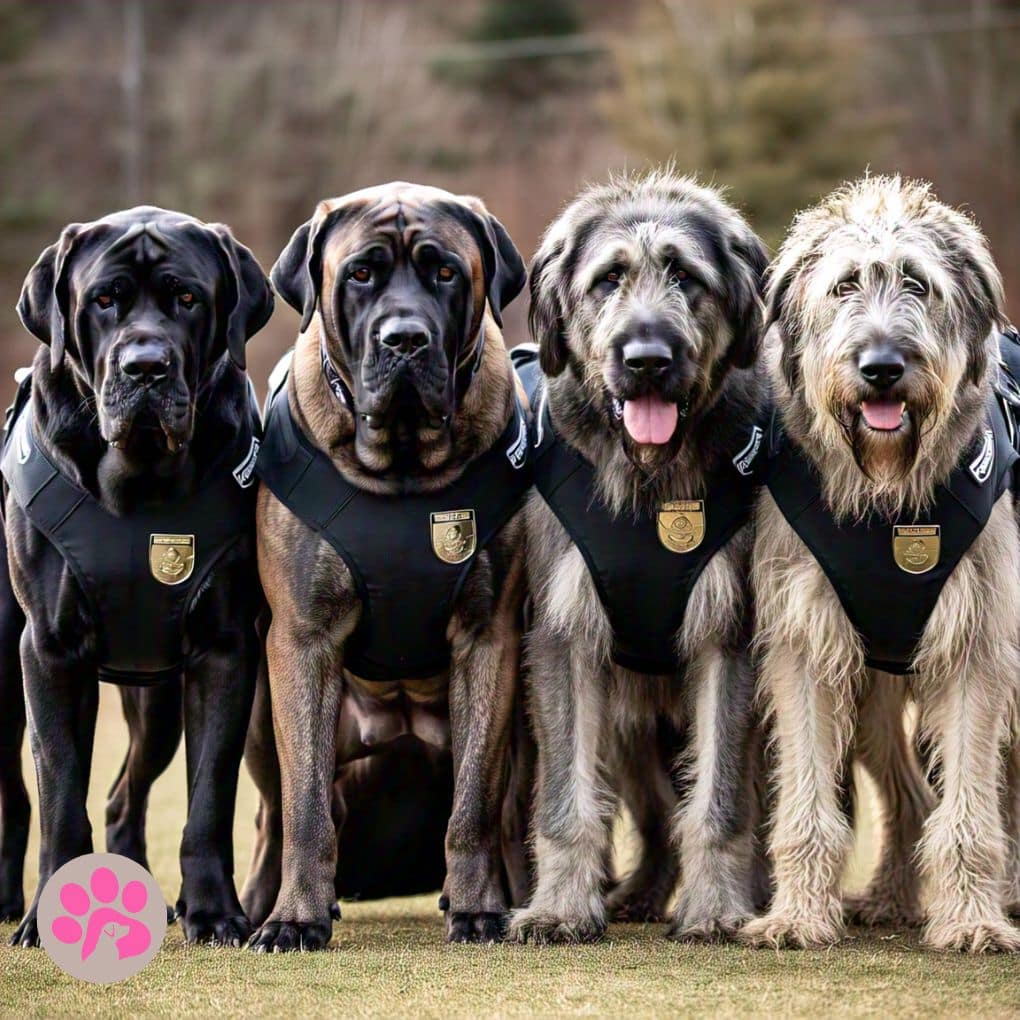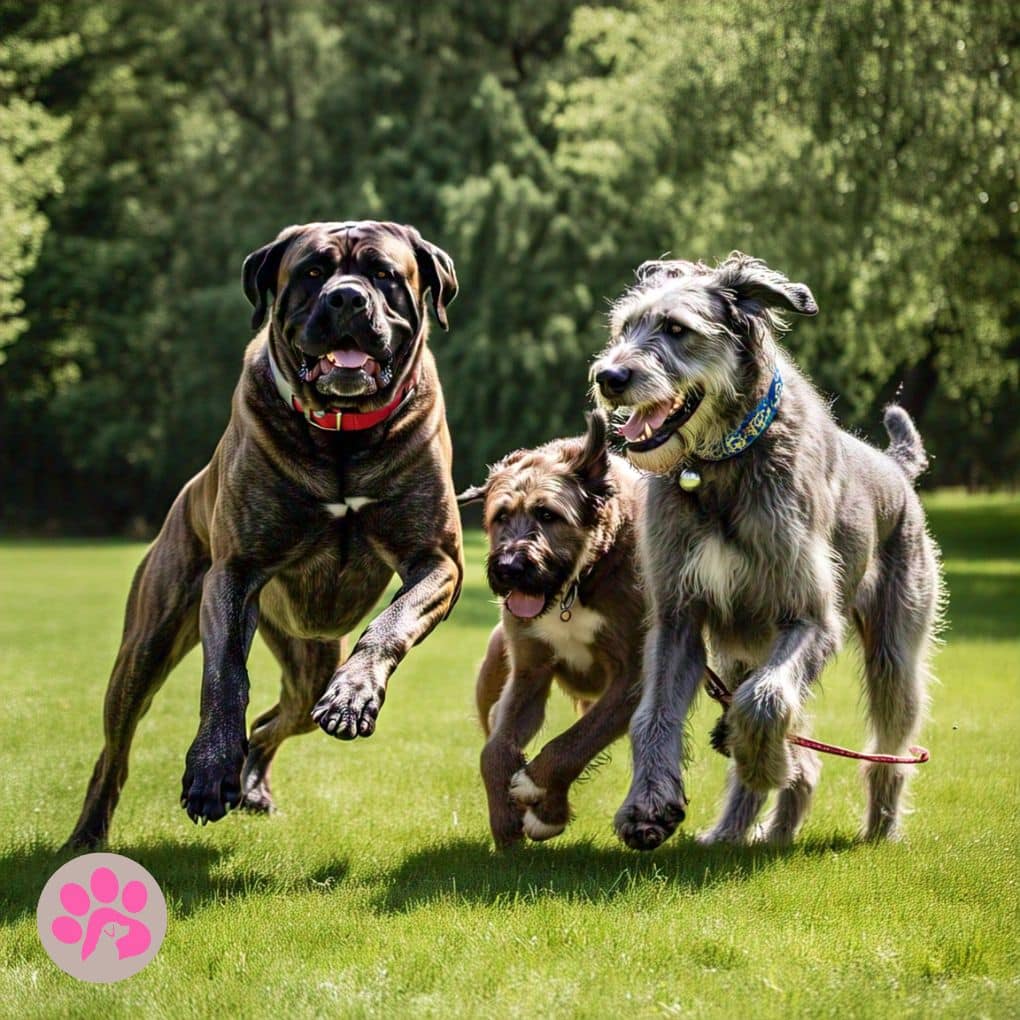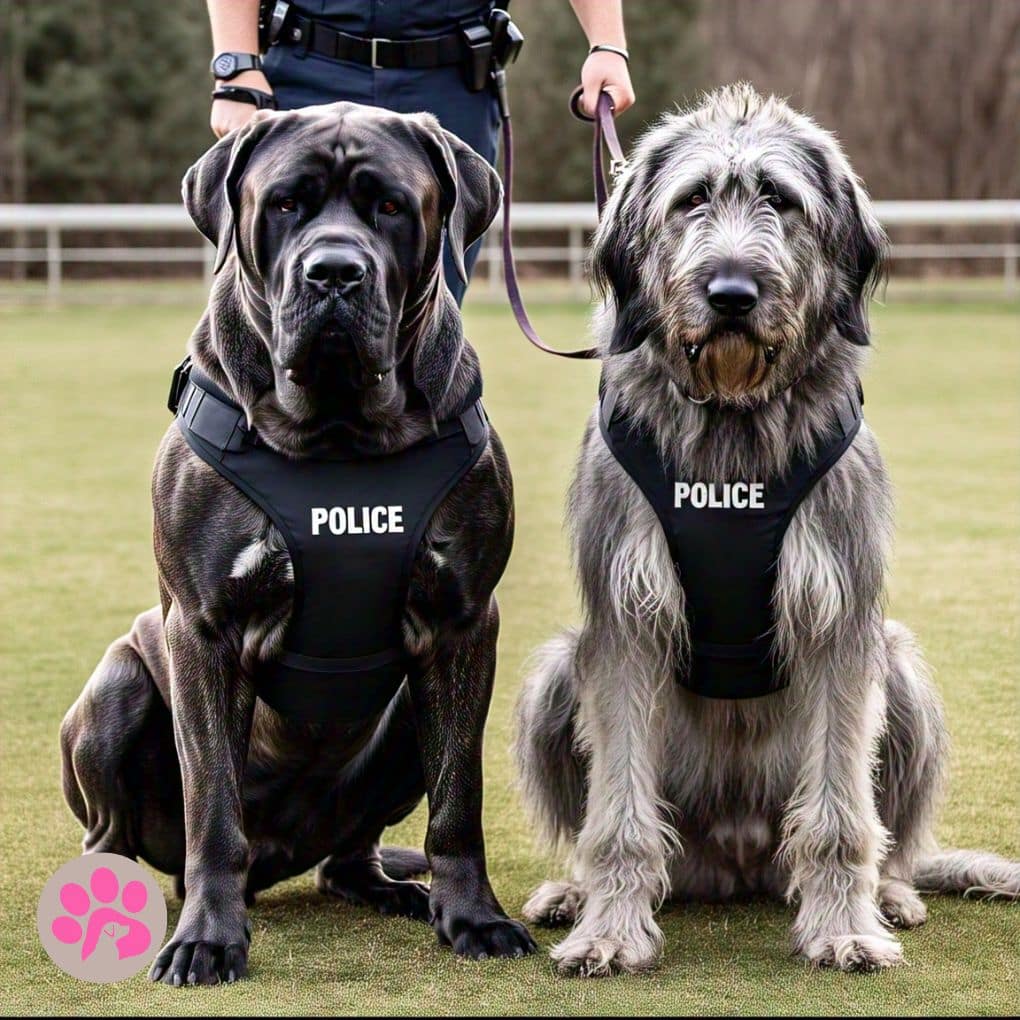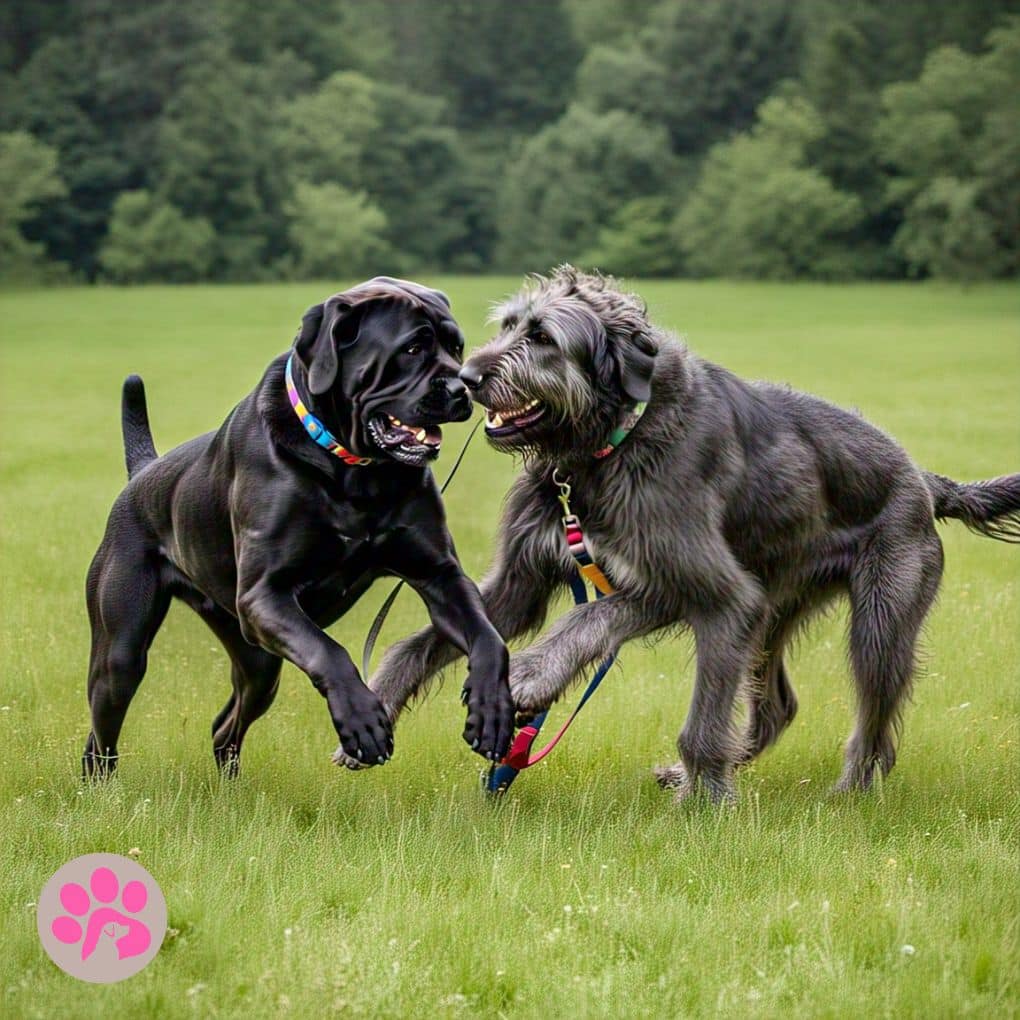Mastiffs and Irish Wolfhounds as police dogs? That may seem like a stretch, but hear us out! The K9 unit has a very different feel when these big breeds are around. People know them for being calm, strong, and loyal. Even though they might not be as fast as a Belgian Malinois or as driven as a German Shepherd. They do have some traits that could make them useful in their own way. To begin, their sheer size is enough to scare off anyone who wants to do harm. A 200-pound mastiff on guard or an Irish wolfhound on the lookout for a suspect is not your standard K9. But it’s hard to ignore their potential.
These soft giants might not be typical police dogs, but their special qualities make them worth looking into. They are very protective of the people who handle them, which makes them great for watching or controlling crowds. Because they naturally know when something is dangerous. They are compliant and could serve as valuable allies in law enforcement. But could these huge breeds really give up their image as family dogs to walk the streets with a badge? Let’s take a closer look at whether mastiffs and Irish wolfhounds could become well-known as unusual but useful police dogs.
Strength in Mastiffs and Wolfhounds:
Mastiffs and Irish Wolfhounds aren’t the most common police dogs. But the unique traits they have make them very useful in certain roles. People love mastiffs because they are big, strong, and loyal. These qualities make them good as police dogs in some situations. Their frightening appearance alone can keep people from committing crimes. And their great strength makes them good at holding suspects down. Mastiffs have a natural instinct to protect, which makes them great at keeping an eye on important things or places.
This makes them perfect for stationary security jobs. These dogs are also very easy to train and very loyal to the people who own them. Because they are calm and level-headed, they can stay cool even in high-stress situations. For example, like controlling crowds or handling tense standoffs. Mastiffs aren’t naturally very aggressive, so when they need to, they can use moderate force. This mix of strength and restraint is very important for law enforcement situations.

Although they might not be the first type that comes to mind when you think of police dogs, Irish Wolfhounds are great in some ways. They can quickly and easily search for people and chase suspects through open areas because they are very tall. Since they are so strong, they can do things like patrol big areas or follow people.
Additionally, Irish wolfhounds are smart and friendly. These traits make them easy to get along with while still being good working dogs.
. Their big size can be scary, but their nice personalities make it easy for them to get along with people. And it is good for both the community and the police. Their enhanced abilities, especially their great eyesight, also help them spy on people and find things.
Both have special skills that, when used correctly, can help police in a number of different tasks. They aren’t used as much in law enforcement as breeds like German Shepherds, but their skills make them very useful.
Loyalty:
A mastiff or Irish wolfhound is a big, strong dog that can keep its person safe. Mastiffs’ big size and scary bark can scare away criminals and warn other people. Criminals are scared off by the fact that they exist. Because they are big and strong, Irish wolfhounds scare away thieves. They are strong, quick, and flexible, which helps them catch and chase things in open areas. Police dogs need to be able to use both physical and mental strength. Both types of dogs can rule a situation; they also know when to act quickly and when to remain calm. Their knowledge, loyalty, and physical strength help them in law enforcement jobs. That needs to be strong and scare people away.
Protective Instincts:
They are both very defensive, which makes them great for police jobs. Mastiffs are naturally guard dogs, so they are very loyal to their owners and keep an eye on their territory. People know that this type of dog will always protect its family or its assigned areas. This makes them very good at security or crowd control.
In the same way, Irish wolfhounds, even though they are calmer, have a natural instinct to protect. Especially when it comes to guarding their masters or reacting to what they see as threats. They can look at things without overreacting because they are cool and patient. However, when they need to, their instincts to protect make them quick to act and strong in stopping any threats. Both breeds are very good at keeping officers, buildings, or private situations safe because they are very loyal. They want to protect what they care about.
Calm Temperament:
Mastiffs and Irish Wolfhounds are both known for being calm, which makes them great police dogs. Especially in places where there is a lot of stress or change. The mastiff is a very large dog, but most of the time they are gentle giants with a calm style. Even when things go crazy, they can handle them well. They can stay calm when things get tense. And that makes it easy for them to focus on the job at hand.

They are great for dealing with tough groups or close fights because of this. In the same way, Irish wolfhounds are known for being calm and patient. They want to keep you safe, but they don’t act right away. These dogs usually keep their cool and think things through carefully before acting. They stay calm, which helps them do well when they need to. Like when they are working with people or watching out for situations that could be dangerous. Both types are calm, which helps them do their jobs carefully and calmly, which makes them good police dogs.
Presence:
One of the most noticeable things about both Mastiffs and Irish Wolfhounds is their size. Because they are so big and strong, mastiffs naturally give off an air of authority that makes people admire them. Being around someone so scary can often stop possible threats before they even do anything. Because criminals are more likely to change their minds when they see someone so scary. People with this strong presence aren’t just showing off. They can use it to take charge in high-stress situations and keep things under control.
The Irish Wolfhound is very tall and has a beautiful build that makes it stand out. It’s not as big as a mastiff. Both can make the people who are in charge of them feel more confident. And the people they are supposed to watch more carefully. This is because they look tall and strong, and they are calm and focused. Police dogs of both breeds are easy to spot, which helps them do their jobs. Jobs such as keeping the peace, controlling crowds, or finding criminals. In this way, they are useful even before they are asked to do something.
Challenges :
Both are smart, but they have very different attitudes and natural traits that can make them hard to train. The fact that mastiffs like being alone is one of their biggest flaws. They care about others and are loyal. But if they don’t see a reason to follow the rules, they can be very set in their ways. When raising Mastiffs, being consistent and patient work better than being rough. This means that the person who is taking care of the dog must be able to be firm but not mean. Since they are usually independent. It might take them longer to learn what to do than breeds that are more eager to please. This means that good behavior needs to be reinforced more often and over and over again.
Even though Irish wolfhounds are usually kinder and more obedient than mastiffs. Their shy and sensitive personalities can make them hard to train. These dogs don’t get as excited about food or toys as some other breeds do. But that can make training lessons harder. Because they are big and strong, they can be hard to control. If you don’t train them properly, especially when they are young and excited. When they are led, Irish Wolfhounds are more likely to follow suit. But they need a trainer who can stay calm and sure of themselves so they don’t get confused or lose focus.

The size and strength of these kinds can also make training them hard. And you will wonder why it is, because it can be hard to get control. Mastiffs and Irish Wolfhounds are both big dogs with a lot of strength. This can make them harder to control if they get sidetracked or if they aren’t trained properly. As an example, a mastiff might act out or refuse to follow directions because it is strong. While an Irish wolfhound might pull on the leash or ignore directions when it’s not fully focused. To do this, trainers need to know a lot about how to keep big, strong dogs focused on the job.
Getting along with other people is another area that can be hard for both breeds. Mastiffs and Irish Wolfhounds are both friendly and loving with their families. But if they aren’t trained properly from a young age, they may be wary of strangers or other animals. There’s a chance that a mastiff might be too wary of new people or situations. And making it hard for them to behave in public. Most of the time, Irish Wolfhounds are friendly, but they might act shy around new people or places. Making sure that both types meet lots of new people and other dogs is important for keeping them open to new experiences. You have to work hard and wait for this to happen.
Speed and agility:
Mastiffs and Irish Wolfhounds may lack the speed and agility required for pursuits.
Energy Levels:
These breeds may not match the stamina of traditional police dogs like German Shepherds or Malinois.
Health Concerns:
Large breeds are prone to joint issues, hip dysplasia, and a shorter lifespan, which could limit their effectiveness.
Training Needs:
Their independent nature can make them more challenging to train for complex police work.
Size Limitations:
Transporting and housing such large dogs can be logistically challenging.
Potential Roles of Mastiffs and Irish Wolfhounds:
Guarding Duties:
Guard dogs like mastiffs and Irish wolfhounds are great at their jobs, especially when they have to stay put and act as a strong barrier. Because they are so big and scary, they are perfect for protecting certain places, like government buildings, offices, or private homes. Because mastiffs are naturally defensive, they are great when they need to be on guard and keep an eye on their zone. Irish Wolfhounds aren’t as mean when they want to guard, but they still have a strong presence that can make them good at watching over valuables or sensitive areas. Both breeds are calm and in charge, which helps them do their jobs without getting upset or reacting too much.
Search and Rescue:
The strong sense of smell in both mastiffs and Irish wolfhounds could make them useful in search-and-rescue missions. They aren’t used in this area as often as breeds like German Shepherds, but their keen sense of smell helps find missing people or people who are in trouble. Being steady and cool helps a lot in high-stress rescue situations, where they can work for a long time without getting tired or cranky. Irish Wolfhounds can search big areas because they are very strong and have good eyesight. On the other hand, mastiffs are tough and strong, which can help them get through rough terrain or rescue tasks where they need to carry heavy loads.

Crowd Control:
Due to their big size, mastiffs and Irish wolfhounds are great for controlling crowds. Just being there can help handle large groups of people without using too much force. Because they are calm, they can handle crowded places without getting angry or violent. This makes them perfect for keeping order at public events, protests, or big meetings. The Mastiff’s natural power and strength make it impossible for anyone who wants to cause trouble to get through, while the Irish Wolfhound’s polite and gentle personality lets them stay in charge with little trouble. Just by being there, their size and presence can help avoid fights. They can calm people down while still being able to make quick decisions if needed.
Final Thoughts
While mastiffs and Irish wolfhounds may not replace traditional police breeds, they could excel in specialized roles that play to their strengths. Their unique characteristics may be better suited for specific environments or non-pursuit tasks.